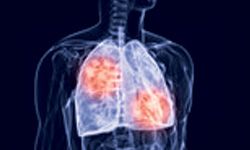Osimertinib Shows Antitumor Activity in NSCLC Harboring Uncommon EGFR Mutations
Osimertinib demonstrated a manageable toxicity profile and encouraging activity in patients with non–small cell lung cancer who harbor an uncommon EGFR mutation, according to results from a phase II clinical trial conducted in Korea.

Osimertinib (Tagrisso) demonstrated a manageable toxicity profile and encouraging activity in patients with nonsmall cell lung cancer (NSCLC) who harbor an uncommonEGFRmutation, according to results from a phase II clinical trial conducted in Korea.
A documented initial response was reported in 15 out of 18 responders (83%) at their first scheduled tumor assessment at 6 weeks. The median duration of response (DOR) was 11.2 months (95% CI, 7.7-14.7 months), and tumor shrinkage was observed in 78% of patients (n = 28). The median best percentage change from baseline in the target lesion size was -35% (range, -79% to 44%).
Eighty-one percent of patients (n = 29) experience disease progression or death as of the data cutoff. Median progression-free survival (PFS) was 8.2 months (95% CI, 5.9-10.5 months). At 6-months, 64% of patients were progression-free (95% CI, 47%-80%), and at 12 months, 39% of patients were progression-free (95% CI, 22%-56%).
As of the data cutoff, 7 patients (19%) had died. Median overall survival (OS) had not been reached. The 12-month OS rate was 86% (95% CI, 74%-98%), and the 18-month OS rate was 56% (95% CI, 39%-73%).
Out of the 7 who did not progress, 5 continued showing response at 11, 18, 19, 24, and 31 months, respectively, after initiation of osimertinib. The 2 remaining patients had stable disease at 11 and 16 months after initiation, respectively.
A subset analysis evaluated overall response rate (ORR) and PFS according to 3 uncommonEGFRmutation types, including G719X, L861Q, and S768I. Objective responses were seen in 78% of patients harboring the L861Q mutation, and the PFS among these patients was 15.2 months (95% CI, 1.3-29.1 months). In the G719X arm, 53% of patients had objective responses, and the PFS was 8.2 months (95% CI, 6.2-10.2 months). In the S768I arm, objective responses were seen in 38% of patients, and the PFS was 12.3 months (95% CI, 0.0-28.8 months). Investigators noted that 4 of these patients harbored a compound uncommonEGFRmutation of G719X and L861Q (n = 2), and G719X and S7681 (n = 2).
Out of 9 patients who had central nervous system (CNS) metastasis at the time of study enrollment, the median PFS was 5.4 months (95% CI, 2.8-8.0 months) compared with 9.8 months (95% CI, 0.8-18.8 months) in patients who did not have CNS metastasis. Among 5 evaluable patients, the intracranial ORR was 40% (n = 2).
One patient with the G719X mutation achieved a complete response in brain metastasis and had multiple enhancing lesions disappear after 6 months with the osimertinib treatment. The CNS DOR was 2.8 months in this patient and CNS PFS was 8.9 months. A second patient with the G719X mutation had a partial response and had a CNS DOR and PFS of 7.0 months and 8.2 months, respectively.
The most common all-grade adverse events (AEs) included rash (31%), pruritus (25%), anorexia (25%), diarrhea (22%), and dyspnea (22%). Nearly all patients experience an AE of any grade (n = 34). The majority of AEs were grades 1 or 2, with only 2 patients experiencing grade 3 AEs including 1 instance each of dyspnea and headache. Only 1 patient required a dose reduction, and no patients discontinued treatment due to AEs.
“In conclusion, to our knowledge, this study is the first prospective investigation of osimertinib in patients with NSCLC with uncommonEGFRmutations. Osimertinib was associated with a high response rate, an encouraging PFS, and a long DOR with manageable toxicity in patients with NSCLC harboring uncommonEGFRmutations. Although a small number of patients were assessed, osimertinib can be considered as a treatment option for patients with NSCLC with uncommonEGFRmutations on the basis of this study,” study authors wrote.
The multicenter, single-arm open-label study enrolled 37 evaluable patients with metastatic or recurrent NSCLC who harbored anEGFRmutation other than exon 19 deletion, L858R and T790M mutations, or exon 20 insertion across 7 institutions in Korea. Patients received 80 mg of osimertinib orally once daily until disease progression, unacceptable toxicity, or withdrawal of consent. Baseline assessments included patient history, physical exam, computed tomography scan/magnetic resonance imaging, and laboratory tests. Physical exams, laboratory tests, and chest x-rays were performed every 3 weeks, while tumors were assessed by tomography scan every 6 weeks according to RECIST 1.1.
The median age of patients was 60 years, and 61% were male (n = 22). Additionally, 44% of patients were never-smokers (n = 16), and 97% of patients had adenocarcinoma (n = 35). The most commonEGFRmutations observed in the trial were G719X (53%), L861Q (25%), and S768I (22%). Osimertinib was administered as first-line treatment in 22 of patients (61%), as second-line treatment in 11 (31%), and as third-line treatment in 3 (8%). Sixty-four percent of patients were diagnosed with metastatic NSCLC and 36% had recurrent disease.
To be included, patients had to have an ECOG performance status of ≤2 and adequate organ and bone marrow function. Patients were excluded if they had previously received anEGFRtyrosine kinase inhibitor, radiation therapy, or chemotherapy within 2 weeks of their initial osimertinib dose on the study. If patients had a documented history of interstitial lung disease, active infection requiring systemic therapy, or uncontrolled brain metastasis, they were also excluded from the study.
Reference:
Cho JH, Lim, SH, An HJ, et al. Osimertinib for patients with nonsmall-cell lung cancer harboring uncommon EGFR mutations: a multicenter, open-label, phase II trial (KCSG-LU15-09) [published online December 11, 2019].J Clin Oncol.doi: 10.1200/JCO.19.00931.